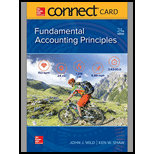
Concept Introduction:
Warranty Expense:
A company may issue warranty with the sale of its product which bounds the company to replace or repair in case of quality failure according to the terms of the warranty. The provision for the estimated warranty liability is made at the time of sale of the products and warranty expense is recorded. This provision is utilized at the time of performing the warranty contract.
Requirement-1:
To Prepare:
The
Concept Introduction:
Warranty Expense:
A company may issue warranty with the sale of its product which bounds the company to replace or repair in case of quality failure according to the terms of the warranty. The provision for the estimated warranty liability is made at the time of sale of the products and warranty expense is recorded. This provision is utilized at the time of performing the warranty contract.
Requirement-2:
To Prepare:
The Journal entry to record the utilization of the estimated warranty
Concept Introduction:
Warranty Expense:
A company may issue warranty with the sale of its product which bounds the company to replace or repair in case of quality failure according to the terms of the warranty. The provision for the estimated warranty liability is made at the time of sale of the products and warranty expense is recorded. This provision is utilized at the time of performing the warranty contract.
Requirement-3:
To Indicate:
The amount of warranty expense recorded by the company for the year
Want to see the full answer?
Check out a sample textbook solution
Chapter F Solutions
Connect Access Card For Fundamental Accounting Principles
- I need guidance on solving this financial accounting problem with appropriate financial standards.arrow_forwardLMN Company reported net income of $87,500 for the year. If the company's total expenses were $142,500, what was the company's total revenue for the year? Answerarrow_forwardHi expert please given correct answer with accounting questionarrow_forward

 AccountingAccountingISBN:9781337272094Author:WARREN, Carl S., Reeve, James M., Duchac, Jonathan E.Publisher:Cengage Learning,
AccountingAccountingISBN:9781337272094Author:WARREN, Carl S., Reeve, James M., Duchac, Jonathan E.Publisher:Cengage Learning, Accounting Information SystemsAccountingISBN:9781337619202Author:Hall, James A.Publisher:Cengage Learning,
Accounting Information SystemsAccountingISBN:9781337619202Author:Hall, James A.Publisher:Cengage Learning, Horngren's Cost Accounting: A Managerial Emphasis...AccountingISBN:9780134475585Author:Srikant M. Datar, Madhav V. RajanPublisher:PEARSON
Horngren's Cost Accounting: A Managerial Emphasis...AccountingISBN:9780134475585Author:Srikant M. Datar, Madhav V. RajanPublisher:PEARSON Intermediate AccountingAccountingISBN:9781259722660Author:J. David Spiceland, Mark W. Nelson, Wayne M ThomasPublisher:McGraw-Hill Education
Intermediate AccountingAccountingISBN:9781259722660Author:J. David Spiceland, Mark W. Nelson, Wayne M ThomasPublisher:McGraw-Hill Education Financial and Managerial AccountingAccountingISBN:9781259726705Author:John J Wild, Ken W. Shaw, Barbara Chiappetta Fundamental Accounting PrinciplesPublisher:McGraw-Hill Education
Financial and Managerial AccountingAccountingISBN:9781259726705Author:John J Wild, Ken W. Shaw, Barbara Chiappetta Fundamental Accounting PrinciplesPublisher:McGraw-Hill Education





